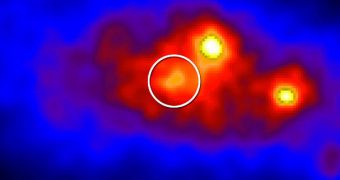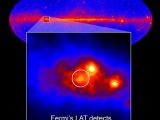The NASA-operated Fermi Gamma-ray Space Telescope has taken a deeper look into a very peculiar binary system, known as Cyngus X-3. It has discovered, in premiere, unambiguous evidence that high-energy gamma-rays are being produced by the structure, something that no other observatory was able to say for certain until now. According to the earliest study results, the system most likely comprises a massive star of high burning temperatures with a weird object, which astronomers say that is either a black hole or a neutron star. Regardless of what it is, the companion was found to be emitting jets of matter into space at half the speed of light. The ejections are active in radio wavelengths.
The reason why such space structures are known as microquasars is because they resemble larger quasars and blazers, which are very distant galaxies believed to be powered by a supermassive black hole at their core. The latter two types of galaxies show the exact same characteristics as their micro cousins, except at larger scale. These traits include rapid changes in the overall brightness of the system, the presence of radio jets, as well as very powerful emissions across multiple wavelengths of the electromagnetic spectrum. Cyngus X-3 was first discovered in 1966. Even with the methods of the time, the structure made itself obvious by being one of the strongest X-ray sources in the sky, Space Fellowship reports.
“Cygnus X-3 is a genuine microquasar and it’s the first for which we can prove high-energy gamma-ray emission,” Paris Diderot University expert Stephane Corbel says. The system was recently observed using the Large Area Telescope (LAT) instrument aboard the satellite. The device is arguably the “crown jewel” in the field of observing high-energy radiation, and the technology advanced to this point largely because astronomers wanted to get closer looks at objects such as Cyngus X-3. Scientists investigating it say that the companion of the massive star in the structure spins around once every 4.8 hours. “This object is most likely a black hole, but we can’t yet rule out a neutron star,” Corbet says.
At the center of the system is a massive Wolf-Rayet star, which is apparently losing mass fast. “In just 100,000 years, this fast, dense wind removes as much mass from the Wolf-Rayet star as our Sun contains,” adds University of Maryland astrophysicist Robin Corbet. The star is estimated to be about 17 times hotter than the one powering up our solar system. The new investigation may provide more accurate insight into how elementary particles are accelerated in space. Details of the Fermi observations are published in the latest online issue of the top journal Science.

 14 DAY TRIAL //
14 DAY TRIAL // 
